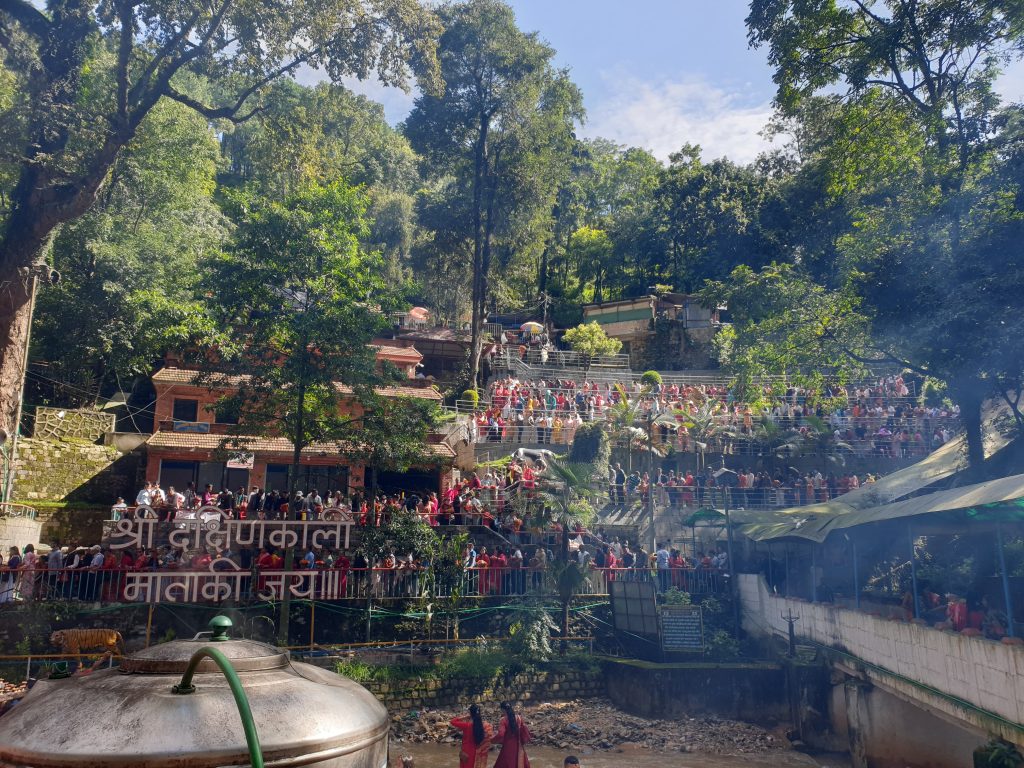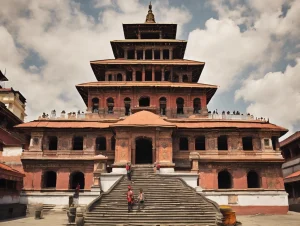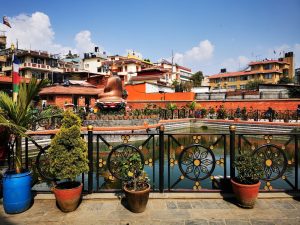The Dakshinkali Temple in Nepal is a significant site, dedicated to a Hindu goddess and spiritual reflection in the Kathmandu Valley. It forever represents belief, devotion, and the merging of religion and nature. The word “Dakshin” in Nepali means “south,” and “Kali,” thus Dakshinkali Temp is formed which represents the goddess, means “south,” thus Dakshinkali is formed (free translation: the goddess of the south). This holy place, which is for the bloodthirsty goddess Kali, is the favorite spot of all those who long for the rich religious history of Nepal and its religious landscape, especially at the Dakshinkali mandir.
Exploring Dakshinkali Temple Nepal
Together with the extension of this, dig into the depths of the place and at the same time plunge into centuries-old customs and faith, which in their final, pristine forms are still based on the ferocious yet benevolent nature of the deity and the calm beauty of nature enveloping one in a hushed embrace. Dakshinkali Temple Nepal holds profound spiritual significance as it embodies the essence of divine power, protection, and transcendence. The temple’s atmosphere is charged with a palpable sense of devotion and reverence, making it a key site for spiritual seekers. It stands as a symbol of the enduring connection between the divine and the natural world, emphasising the harmonious coexistence of spirituality and nature.

The Spiritual Importance of Dakshinkali Temple Nepal in Hinduism
In Hinduism, the Dakshinkali Temple is a significant site for the worship of Goddess Kali, revered as a fierce and protective deity. Her worship is deeply ingrained in Nepalese culture, where she is seen as a guardian against evil and a symbol of feminine power.
The Legend and Spiritual Significance of Dakshinkali Temple
Local mythology holds that the Dakshinkali Temple in Nepal was established following a divine dream where the goddess appeared to a King Malla. According to this legend, Goddess Kali appeared to a farmer in a vision, instructing him to construct a temple at a specific location. This divine directive led to the creation of Dakshinkali Temple, establishing it as a sacred space devoted to the goddess.
Historical and Cultural Importance of Dakshinkali Temple
Dakshinkali Temple holds an important place in the religious, cultural, and historical traditions. Countless people from various parts of Nepal and even foreign countries visit the temple to receive the blessings of Goddess Kali. People often visit the temple when they are facing some hardships in their lives and plead for the protection and guidance of the goddess. In addition, many people have faith in the power of Kali to protect them from evil forces and help them when they are going through hard times. Dakshinkali Temple has served as a major spiritual centre for generations.
Perhaps the most famous ritual worldwide at the temple is the daily practice of animal sacrifice. This act is performed with the goal of seeking protection from evil and misfortune through the power of the fearsome goddess. Animal sacrifice here is a tradition rooted in the local culture but is also tied to the belief that the divine is made present through an act of violence on a living being. In Hindu spirituality, this represents a symbolic aspect of the goddess.
While this practice may initially seem shocking, it holds deep relevance in its connection to violence and sacrifice. However, it is just one part of a larger set of spiritual practices. The sacrifices at the Kali temple honor the goddess and provide a way to access her protection. They also serve as a form of human training, helping people understand the world as it truly is. The goddess destroys the enemies of the world—those forces of evil that prevent the divine from manifesting in a balanced and whole world.
Festivals and Celebrations at Dakshinkali Temple
For many people, the Dashain Festival, held in October, is one of the biggest festivals at Dakshinkali Temple. This festival centers on the devotion to goddess Durga and, like all festivals, it is celebrated with much pomp and zeal. During Dashain, the temple is beautifully decorated, and many come to offer prayers and sacrifices. The atmosphere is enhanced by the rhythmic beating of drums, the clang of cymbals, and the blare of conch shells, which inspire the people present at the temple. Mothers usually come with children to pray for safety, accomplishment, and health and the dissolution of impediments in their lives. A few believe that by presenting sacrifices or praying to ladies dressed in the form of Kali, they will achieve their nemeses and surmount their problems.
The Physical Geography of Dakshinkali
In addition to its religious aspects, the landscape ornamenting Dakshinkali Temple in Nepal is quite beautiful. The shrine is located close to the village of Pharping, which is also the abode of the tranquil Sheka Narayan. This place has a beautiful pond with clear water and fishes in it, which makes it a very pleasant place for people. The walk amidst the hills, the old rope bridge spanning across the gorge, and the vision of the deep gorge makes the trip of Dakshinkali quite a blissful one.
Mahakali: Devastating yet Illuminating Deity
Mahakali is presented as a fierce female deity, having three eyes and skin colored in deep blue that stands for the sun, the moon, and flame in the Hindu doctrine. In her talons, however, wisdom and light coexist. For instance, the goddess endowed the Sanskrit poet Kalidasa, whose name refers to him as the “servant of Kali,” with divine knowledge, which, in turn, enabled him to create many masterful works of Sanskrit literature. Before turning to the goddess blessings, everyone considered Kalidas uneducated but with the help of divine knowledge, he produced treasured works of Sanskrit literature.
A Place of Worship and a Sanctuary
For many visitors, Dakshinkali Temple is not just a place for religious worship but also a sanctuary for inner peace. Located far from the noise and pollution of the Kathmandu Valley, the temple offers a peaceful environment for devotees to connect with God. Families visit the temple to pray for safety, prosperity, and the removal of obstacles in their lives. Worshiping Goddess Kali and performing animal sacrifices are believed to help people overcome both internal and external enemies.
Dakshinkali Temple functions year-round, with various activities scheduled according to a yearly calendar. The temple is especially known for its animal sacrifices, which take place on Saturdays and Tuesdays, the designated days for worship.
Key timings for the temple events.
Days and times for regular worship and sacrifice :
Saturday: 6.00am to 12.00pm (main day for sacrifices).
Tuesday: 6 am to 12 pm.
A special day with a significant congregation of people, usually for the major festival of the following timing is:
Dashain Festival (October): People flock in and out of the temple at all times throughout the day with the aim of performing puja, with soft activities starting at the morning and stretching till in the evening.
Tihar Festival: During the Tihar Festival, special pujas and offerings may be made, though they are not specifically related to the Dakshinkali Temple
The temple is open to visitors from sunrise to sunset every day, although it is most visited at this time of the event.
How do I reach the Dakshinkali Temple in Nepal?
There are many ways to get to this temple, which is 22 kilometers southwest of Kathmandu according to one’s choice as follows:
By Public Transport:
Local Bus:
There is a bus service from Ratnapark (Old Bus Park), which takes one to the Dakshinkali temple area. Buses to Pharping or Dakshinkali are taken, and this will take roughly 1.5 hours based on the road conditions.
Microbus/Van:
Microbuses also operate from Ratnapark or Kalanki. With these, you will arrive at your destination faster than with the rest of ordinary bus transportation, as well as move in full comfort.
By Private Vehicle:
Taxi:
Renting a cab in Kathmandu and proceeding toward the temple takes about 45-60 minutes depending on how heavy the traffic is. The price differs based on distance; however, prepare to pay around NPR 1500-2000 for the round trip.
Car/Bike:
If driving is your chosen ambition, then you will not have any difficulty finding way yourself in Dakshinkali Temple in Nepal. This is an easy road to Kathmandu. First, one has to take the road to Pharping and then head within the direction of Dakshinkali. The track is easy to follow, and the direction signs are already in place along the journey.
By Tour/Private Hire:
For a comprehensive trip, you can also opt to book a guided tour or hire a private vehicle. This is quite perfect if you wish to include other areas like Pharping or Chovar dada as well.
On getting to the site, you would trek a short distance down below the hill up to the temple, which is tucked in a valley with thick trees all around.
Hiking Routes Near Dakshinkali Temple in Nepal
Dakshinkali temple and the area around it are not only a place for people seeking peace and tranquillity. There is plenty of adventure for those willing to get out and explore by foot. In this area, there are many hiking trails, which can be quite peaceful – away from the busy urban life. People trekking these days should know the routes and the relevant terrain. This helps them prepare for the trek accordingly.
Looking for day hiking trips inside the Kathmandu valley?
Champadevi hill hiking could be the best choice for you. Champadevi (Devi refers to goddess Kali) is a pilgrimage site for both Hindu and Buddhist people. A major festival takes place on the full moon day during Baishakh (lunar calendar), which falls in May.
Location and Spiritual Importance of Champadevi
Champadevi Temple lies at an elevation of 2,285 meters above Dakshinkali Temple and Pharping Village.There are several Kali temples around the Kathmandu valley, and a special ceremony is held during the Dashain Festival.
The Spiritual Journey through Monasteries
The spiritual landmarks such as Pharping Monastery and various monasteries will be passed while hiking. Pharping Cave is one of the largest and most sacred pilgrimage sites for Buddhists, where Padmasambhava is said to have meditated. The hike starts from the gentle incline of Taudaha and ends up at Dakshinkali Temple. The scenic trail goes through a lovely pine forest, and it will take roughly 2 hours to get to the ridge. Scenic Views Along the Champadevi TrailWhile trekking on the Champadevi hiking trail, you can see panoramic views of the Langtang range, Mt. Gauri Shanker, Jugal, and Dorge Lakpa mountain ranges. Additionally, the hikers are greeted with refreshing views of the Kathmandu Valley, Patan, and Bungamati Khokana village which are also positioned in the far corner of the sky, but only if the weather is good.
Best Seasons for Champadevi Hiking
The Champadevi Temple is situated in a pleasant forest surrounded by trees.The Champadevi hike offers beautiful views and can be enjoyed year-round. However, it’s best to avoid the monsoon season from June to the end of August. During the monsoon, the hills become lush and green. However, be prepared for leeches if you decide to hike in this season. The spring season is a time of great beauty, when all the flowers, including the rhododendrons, are in full bloom. There are many temples of Kali around the Kathmandu valley and a special ritual takes place during the Dashain Festival.The Spiritual Journey through MonasteriesOn the way, we will also encounter spiritual sites such as Pharping Monastery and other monasteries.
The Spiritual Journey through Monasteries
While hiking, we will pass through spiritual landmarks like Pharping Monastery and other monasteries. Pharping Cave is one of the largest and most sacred pilgrimage sites for Buddhists, where Padmasambhava is said to have meditated. The hike begins gently uphill from Taudaha, before reaching Dakshinkali Temple. The trail leads through a beautiful pine forest, and it will take approximately 2 hours to reach the top of the ridge.
Scenic Views Along the Champadevi Trail
While trekking on the Champadevi hiking trail, you can see panoramic views of the Langtang range, Mt. Gauri Shanker, Jugal, and Dorge Lakpa mountain ranges. The trail also offers sights of the Kathmandu Valley, Patan, and Bungamati Khokana village in the distance, though the view may be dusty and foggy at times.
Best Seasons for Champadevi Hiking
The Champadevi Temple is a small, serene site surrounded by trees. You can enjoy the Champadevi hike year-round, though it’s best to avoid the monsoon season. If you don’t mind the rain, you’ll find lush greenery covering the hills. However, be prepared for leeches during this time. The spring season is particularly beautiful, with flowers in full bloom, including rhododendrons.
Champadevi hill hike is about 15 km from Dakshinkali temple. As the name suggests, it is one of the well-frequented trails in the Kathmandu valley. The hike takes around 2 to 3 hours to reach the top, near Pharping. Along the way, trekkers pass many historical places. The trail climbs through thick pine forests and terraces. It reaches an elevation of 2278 meters at the peak of Champadevi Hill. The path offers good views of the Kathmandu Valley. On a clear day, the Langtang range and even the distant Himalayan range are visible. This trek would suit people who want a short but interesting excursion in the vicinity of the valley.
Pharping to Hattiban Hike
The other option that you can try is the Pharping to Hattiban Hike, which is about 6-8 km and will take about 3-4 hours of walking time. This hike is comparatively peaceful because of the pine woods and quiet villages scattered around, thus serving a nice getaway from the town. The trail eventually reaches Hattiban Resort, which is famous for its view of the Himalayas and venues for rock climbing. This route offers a good scope for a long walk interspaced with the visit of local people and their old village.
Dakshinkali to Markhu Hike
For those adventurers who want a little longer huff and puff, the Dakshinkali to Markhu Hike extends for around 20 km and requires 5 to 6 hours for one to complete it. Here you start from the temple to a place called ‘Markhu’ which is near the Kulekhani Reservoir . Hikes such as this are a blend of forests, farmland, and their settlements on the way. This area is ideal for adventures who want long and tiring but satisfying treks with beautiful views of the lake and the mountains in the backdrop.
Pharping to Champadevi via Bhasmasur Hill Hike
An alternative hiker’s route is Pharping to Champadevi via the Bhasmasur Hill hike, which is about 7 km long and takes about 4–5 hours. The trekking starts from the Pharping area, and there is the climb towards Bhasmasur Hill with great views and cultural attractions. The route, however, joins the Champadevi peak, and hence the trekkers enjoy both the culture and history.
Dakshinkali to Chovar Gorge Hike
In addition to that, the Dakshinkali to Chovar Gorge Hike is another scenic 12 km trek with a duration of approximately 3 to 4 hours. This will also shorten the everyday hiking, sparing you from the temple to the green rolling hills toward the Chovar Gorge, which holds mythological importance. This hike is ideal for people searching for simple walks with pleasant views.



